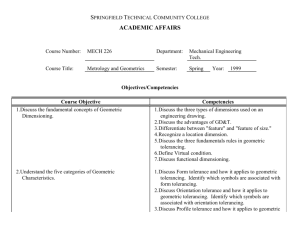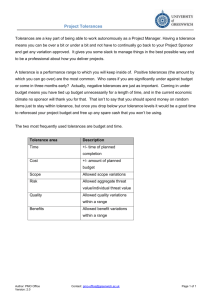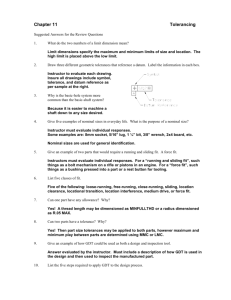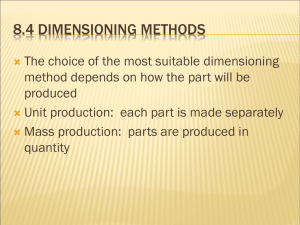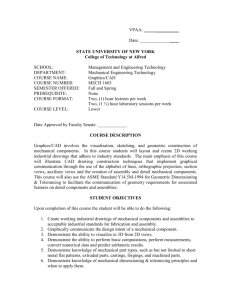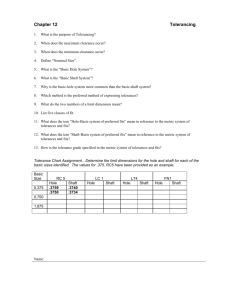Chapter 16
advertisement
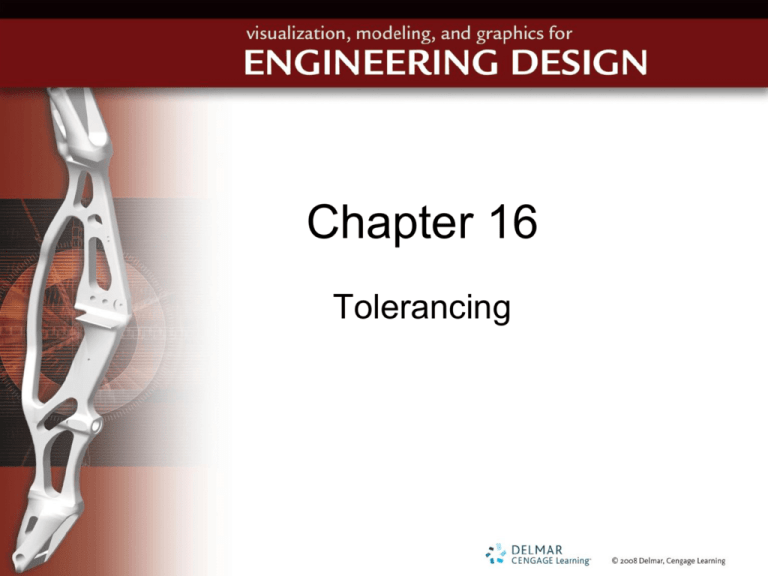
Chapter 16 Tolerancing Objectives • Describe the purpose of conventional tolerancing and its limitations • Use standard tables to specify an appropriate fit between two mating parts • Explain the advantages of using geometric dimensioning and tolerancing (GD&T) over conventional tolerancing Objectives (cont’d.) • Recognize the datum reference frame on a drawing with geometric dimensions and tolerances • Describe the tolerance zone shape for each geometric tolerance • Correctly read the feature control frames on a drawing with geometric dimensions and tolerances Introduction • Relationships between different parts – Necessary to specify intended fit between parts • Problems with inexperience in new engineers – Lack of knowledge in history, materials – Inappropriate tolerance values Formats for Tolerances • Displayed in several common formats FIGURE 16.03. Formats for tolerance dimensioning in millimeters and inches. Tolerance Buildup Problems • Can be minimized depending on type of dimensioning – Chain: yields largest tolerance buildup – Baseline: can eliminate some accumulation – Direct: best way to eliminate tolerance accumulation • Single dimension placed between two key points Statistical Tolerance Control • Based on sound statistical practices • Can be applied only when appropriate statistical process control methods used FIGURE 16.07. Tolerancing with statistical process control. Use of Tables for Fits • Types of fits FIGURE 16.08. Specifying a CLEARANCE FIT with limit dimensioning. FIGURE 16.09. Specifying an INTERFERENCE FIT with limit dimensioning FIGURE 16.10. Specifying a TRANSITION FIT with limit dimensioning. Fit Terminology FIGURE 16.11. Clearance fit terminology. FIGURE 16.12. Interference fit terminology. English Fits • • • • • Running or sliding clearance Locational clearance Locational transition Locational interference (see next slide) Force or shrink (see next slide) English Fits (cont’d.) FIGURE 16.18. Locational interference and force fits. Metric Fits FIGURE 16.19. Metric fit table. Fits Tables • To specify an inch fit between holes and shafts from a standard table – Determine type of fit appropriate for the design and locate corresponding table – Determine basic size of the parts – Find size range on the table – Determine tolerances for hole and shaft – Remember that values on the English tables are in thousandths of an inch Fits Tables (cont’d.) FIGURE 16.23. A close sliding fit. Fits Tables (cont’d.) • To determine metric fits – Determine type of fit appropriate for the design and locate corresponding table – Determine basic size of the parts – Find the size range on the table – Determine the tolerances for the hole and the shaft Conventional Tolerancing versus Geometric Tolerancing • Feature with size – Cylindrical or spherical surface or set of two opposed elements or opposed parallel surfaces associated with size dimension • Feature without size – Planar surface or a feature where the normal vectors point in the same direction Conventional Tolerancing versus Geometric Tolerancing (cont’d.) FIGURE 16.29. Conventional tolerance dimensioning of a block. Conventional Tolerancing versus Geometric Tolerancing (cont’d.) FIGURE 16.30. How conventional tolerancing controls surfaces. Location of Holes and Pins with Conventional Tolerancing FIGURE 16.35. Square tolerance zones from conventional tolerancing. Geometric Dimensioning and Tolerancing (GD&T) • GD&T is a 3-D mathematical system for describing the form, orientation, and location of features on a part within precise tolerance zones – Better communication throughout design process – Almost nothing can be interpreted in more than one way The Datum Reference Frame FIGURE 16.40. Components of the theoretical datum system. The Datum Reference Frame (cont’d.) FIGURE 16.41. Datum terminology. Geometry Characteristic Symbols and Feature Control Frames FIGURE 16.42. Geometric characteristic symbols. Geometry Characteristic Symbols and Feature Control Frames (cont’d.) • Feature control frame – Contains geometric characteristic symbol, the geometric tolerance, and the relative datums FIGURE 16.44. A feature control frame with the perpendicularity tolerance. FIGURE 16.45. A feature control frame with the position tolerance. Order of Precedence for Datums FIGURE 16.47. The sequence of datum features Position Tolerances versus Conventional Tolerances FIGURE 16.49. Geometric dimensioning and tolerancing of the PLATE. Position Tolerances versus Conventional Tolerances (cont’d.) • Basic dimensions – Theoretically exact • Maximum material condition modifier – Size of zone changes if size of hole changes • Square vs. cylindrical tolerance zones FIGURE 16.53. Cylindrical tolerance zones for the position tolerance. Form Tolerances • For individual features and not related to datums – Straightness – Flatness – Circularity – Cylindricity Profile Tolerances FIGURE 16.63. Profile of a line. Profile Tolerances (cont’d.) • Profile of a surface • Inspection of profile tolerances – Optical comparitors – Overlay charts – Mechanical gaging • Used when datum reference frame applied Orientation Tolerances • Parallelism tolerance – Can be used to control a surface FIGURE 16.69. Parallelism tolerance used to control a surface. Orientation Tolerances (cont’d.) • Perpendicularity • Angularity FIGURE 16.78. Inspecting the angularity between two surfaces. Location Tolerances • Position – Can be used to locate axis of a hole FIGURE 16.79. Using the position tolerance to locate the axis of a hole. Location Tolerances (cont’d.) • Concentricity – Applied to cylinder FIGURE 16.81. Concentricity applied to a cylinder. • Symmetry Runout Tolerances • Circular runout • Total runout • Multiple datums – Tolerances applied based on function, so careful specification of datums is necessary Examples of Specifying Fits and Geometric Tolerances • Specifying the fit between two parts FIGURE 16.99. Coupling assembly. Examples of Specifying Fits and Geometric Tolerances (cont’d.) FIGURE 16.101. Limit dimensions for the STUD and BUSHING. Adding Geometric Dimensions FIGURE 16.102. PLATE ASSEMBLY. FIGURE 16.103. Establishing the datums on the PLATE. FIGURE 16.104. Controlling the datums on the PLATE. FIGURE 16.105. Positioning the hole on the PLATE. FIGURE 16.106. Controlling the other surfaces on the PLATE. Summary • Covered basic information related to conventional tolerancing and GD&T • Discussed interchangeable manufacturing and explained why it is important to the way modern industry functions Summary (cont’d.) • Discussed conventional tolerancing, including how to specify fits and how tolerance dimensions control form and location • Covered the basics of geometric dimensioning and tolerancing Summary (cont’d.) • Discussed the advantages of geometric tolerancing over conventional tolerancing • Explained the importance of the datum reference frame to establish a coordinate system for design manufacturing and inspection • Explained how to read feature control frames • Described each geometric tolerance
